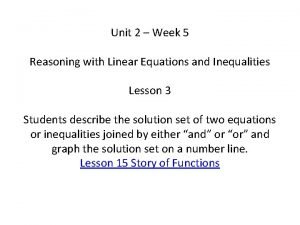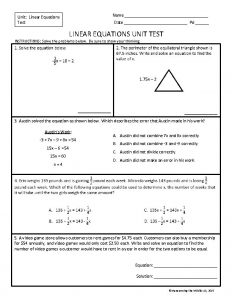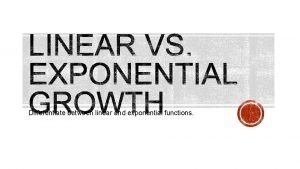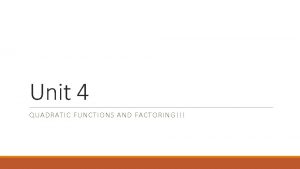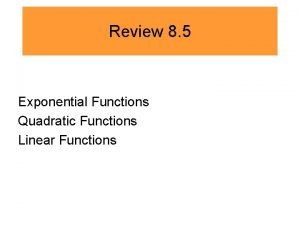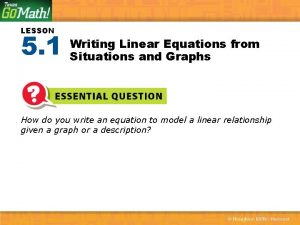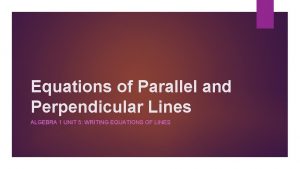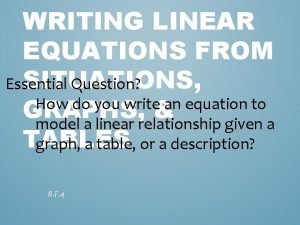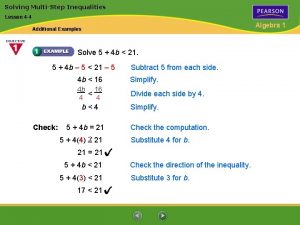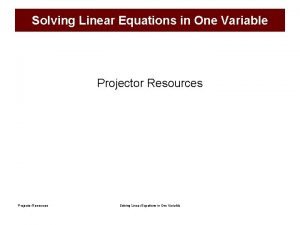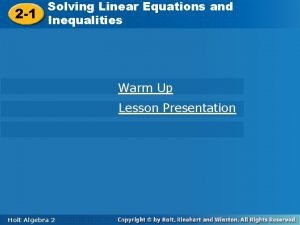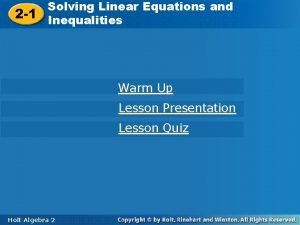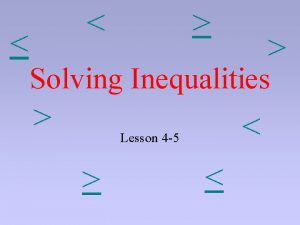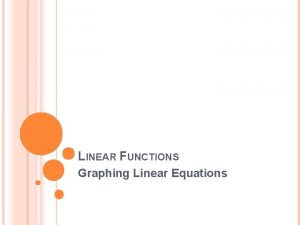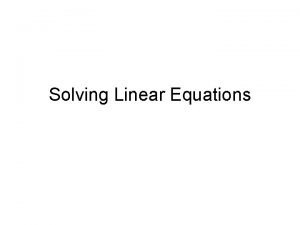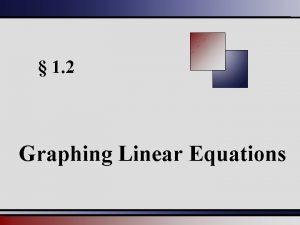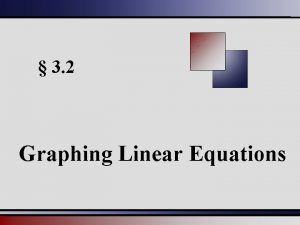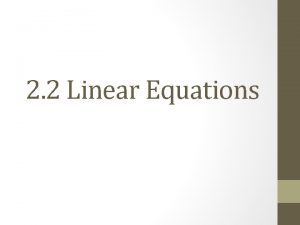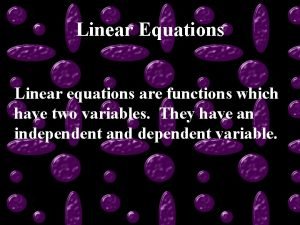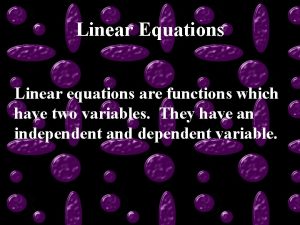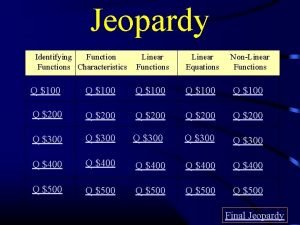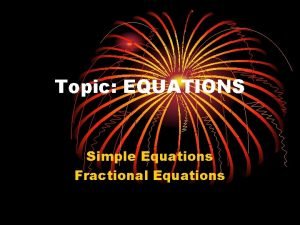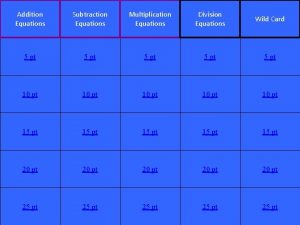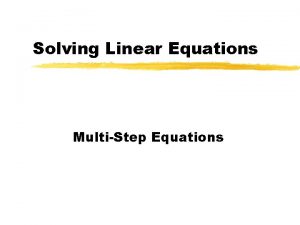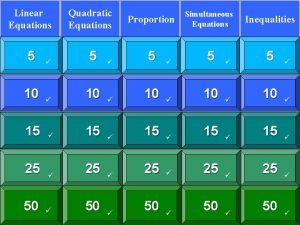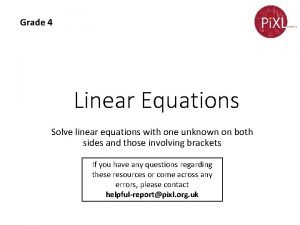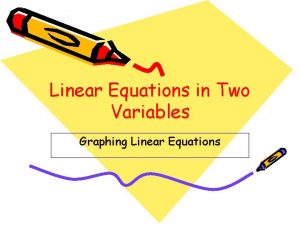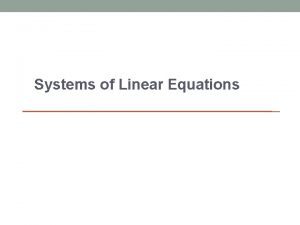Unit 2 Linear Equations and Functions Unit Essential



























- Slides: 27

Unit 2 Linear Equations and Functions

Unit Essential Question: What are the different ways we can graph a linear equation?

Lessons 2. 1 -2. 3 Functions, Slope, and Graphing Lines

What is a function? Domain Range

Rate of Change = Slope

Graphing Linear Equations Slope Intercept Form Standard Form Horizontal Vertical

Homework: Have a good weekend!

Bell Work:

Lesson 2. 4 – 2. 6 Parallel/Perpendicular Lines, Standard Form, and Direct Variation

Parallel Lines that never intersect. If two lines never intersect, then they must have the same… SLOPE!!!!!! The lines y = 3 x + 10 and y = 3 x – 2 are parallel!!!

Perpendicular Lines Intersecting lines that form 90 degree angles. Perpendicular lines have the opposite-reciprocal slope. The lines y = 3 x + 4 and y = -1/3 x – 8 are perpendicular.

Standard Form Ax + By = C, where A, B, and C are integers (not fractions or decimals). To graph a linear equation in standard form, find the x and y intercepts. X-intercept: this is when y = 0, so simply plug 0 in for y, and solve for x. Y-intercept: this is when x = 0, so simply plug 0 in for x, and solve for y.

Direct Variation In the form y = kx, where k is the constant of variation. To find an equation in direct variation form, you use a given point to find k. Example: If y varies directly with x, and when x = 12, y = 6, write and graph a direct variation equation.

Homework: Page 102 #’s 20 – 25, 40 – 45 Page 109 #’s 3 – 29 odds

Bell Work: 1) Write the equation of a line in standard form that passes through the point (6, -2) and is perpendicular to the line y = -3 x + 4. 2) If y varies directly with x, and when x = 10, y = -30, write and graph a direct variation equation.

Lesson 2. 7 Absolute Value Functions

Lesson Essential Question: How do we graph an absolute value function, and how can we predict translations based upon its equation?

Example:

Examples:

Examples with Transformations:

Homework: Page 127 #’s 3 – 20

Bell Work:

Stretching/Shrinking When the absolute value function is multiplied by a number other than 1, it causes the parent function to: Stretch if the number is greater than 1. Shrink if the number is between 0 and 1.

Transformations: This is when a basic parent function is translated, reflected, stretched or shrunk. Translation: when it is shifted left, right, up, or down. Reflection: when it is reflected across the focal point. (multiplied by a negative) Stretched: when it is vertically pulled (multiplied by a # > 1). Shrunk: when it is vertically smushed (multiplied by a # between 0 and 1.

Examples:

Homework: Page 127 #’s 3 – 20

Bell Work:
 Quadratic simultaneous equations
Quadratic simultaneous equations Difference between linear and non linear equation
Difference between linear and non linear equation Simultaneous equations linear and non linear
Simultaneous equations linear and non linear Unit 2 reasoning with linear equations and inequalities
Unit 2 reasoning with linear equations and inequalities Characteristics of lipids
Characteristics of lipids Unit 4 writing linear equations
Unit 4 writing linear equations Absolute value
Absolute value Unit 4 linear equations
Unit 4 linear equations Linear systems unit test
Linear systems unit test Unit 6 radical functions homework 6 radical equations
Unit 6 radical functions homework 6 radical equations Core functions and essential services of public health
Core functions and essential services of public health Core functions and essential services of public health
Core functions and essential services of public health 6 essential nutrients and their functions
6 essential nutrients and their functions Difference between linear and exponential functions
Difference between linear and exponential functions Linear and quadratic functions and modeling
Linear and quadratic functions and modeling Unit 4 test solving quadratic equations and complex numbers
Unit 4 test solving quadratic equations and complex numbers Linear exponential quadratic
Linear exponential quadratic Forming equations worksheet
Forming equations worksheet Writing linear equations from situations and graphs
Writing linear equations from situations and graphs Perpendicular lines in real life
Perpendicular lines in real life 5-1 writing linear equations from situations and graphs
5-1 writing linear equations from situations and graphs 5-3 solving multi-step inequalities
5-3 solving multi-step inequalities Building and solving linear equations
Building and solving linear equations 2-1 solving linear equations and inequalities
2-1 solving linear equations and inequalities Algebra 2 inequalities
Algebra 2 inequalities Lesson 4-2 absolute value inequalities
Lesson 4-2 absolute value inequalities Linear or nonlinear
Linear or nonlinear Lesson 5 graphing linear equations and inequalities
Lesson 5 graphing linear equations and inequalities



